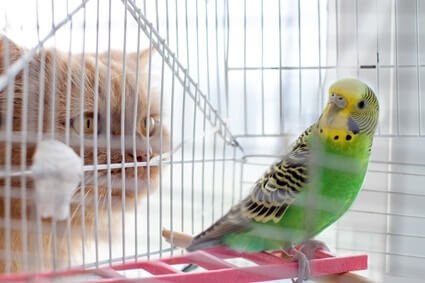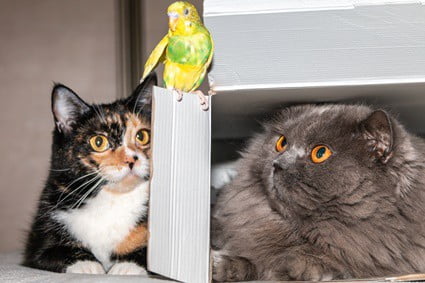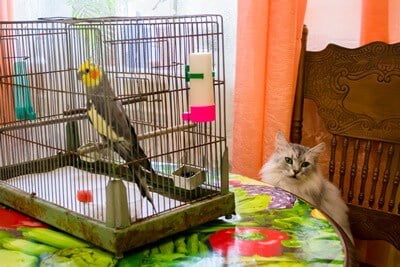Cats are either stealthy hunters or sleepy balls of fluff. This makes it hard to determine the outcome if you mix cats with other animals. That goes double for birds since they are the natural prey of felines. Parrots are loud, colorful, and intelligent, but many species in the wild have been hunted to near extinction by feral cats.
Cats and parrots can live together in the same home, but they’re unlikely to become friends. Owners keep large and small parrots with their cats, but you need to introduce them safely and encourage them to give each other space. Never let your parrot and cat roam freely at the same time. Monitor all interactions, train the cat to stay away from the bird cage and choose a large parrot.
Mixing older parrots with young kittens will lower the chance of fighting or attacks. However, accidents still happen, and cats have even been known to stare parrots to death. That means you will always need to remain vigilant. Be sure to reprimand any signs of stalking, hunting, or antagonizing from your cat.
Can Cats And Parrots Live Together?
Many people keep parrots and cats in the same home, but there are no attacks, injuries, or undue stress. However, this peaceful scenario doesn’t happen naturally on its own.
It’s a delicate balance to make cats and parrots co-exist. That’s because cats are hunters that naturally predate on birds. Even domesticated cats that are well-trained and never exposed to birds will react aggressively when given access to one. It’s a hard-wired instinct that all cats have, no matter their breed, and they will view any species of bird as a:
- Food source
- Toy to bat around
- Object to hunt or antagonize for exercise or to sharpen their skills
While you can take every precaution available, there is still a chance that your cat will attack your bird. In fact, outdoor cats have significant effects on bird populations in their area. According to Nature Communications, outdoor cats kill about 2.4 billion birds every year.
It’s impossible to train this habit out of a cat completely. You can teach a cat to stay away from the bird cage by reprimanding it whenever it tries to approach the parrot. However, you can never trust a cat to act peacefully if a parrot is out of its cage and within reach. This goes doubly if the cat is left unsupervised. As such, the only way for parrots and cats to get along is if you:
- Set up boundaries
- Monitor them carefully
- Do not give them access to one another, especially at night
- Establish safeguards in case hunting instincts kick in

Cats And Birds In The Same House
Cats and birds can live in the same household. This is true whether they’re a large macaw or a tiny finch. However, you should expect certain confrontations.
These fights can happen at any point. It doesn’t matter if the two pets are newly introduced or years into sharing a home. Both cats and parrots can be trained, and they can be taught to behave. However, you will be unable to erase millions of years of hunting instincts and evolution.
Are Parrots Scared Of Cats?
Parrots are afraid of cats. Because it’s a prey animal, a parrot’s brain is naturally hardwired to be afraid of cats. This even translates into non-threatening stimuli. A parrot’s hyperawareness for predators can make it stressed about:
- Loud TVs
- Multiple guests in the home
- Exposure to small children that move quickly
- Flashing lights from passing cars
You can then imagine how a parrot will react when faced with the real deal: a whole cat, with its claws, its stalking behavior, and its nimble ability to jump to and fro. Even from behind the safety of cage bars, parrots naturally understand their need to fear cats.
Of course, every parrot will be different. If introduced to your cat, one parrot might scream, flap its wings, and try to escape. Another may appear unaffected until the cat does something to intentionally startle it, such as engaging in a staring contest or bat at its cage. On some level, you can expect every parrot to be mildly unsettled by a cat, even if it’s never seen one before.
Parrots have been known to move as far back in their cages as possible when they are scared. Others have been known to bite at and antagonize a cat to frighten it away. Even if your cat never pays it any mind, the parrot will be devoting some part of its attention to the feline when it’s in the room.
Will Cats Attack Parrots?
Cats are capable of attacking a parrot. Most of the time, your cat won’t mean to upset you or disobey your training when it does. Rather, it will just see a flash of stimulus that’s biologically unnatural to ignore, such as the:
- Fluttering of feathers
- Quick movements of flight
- Smell of prey
- Calls or cries of prey
- Quick scurry of a small animal
That means your parakeet rushing across a table to meet you can kick your feline’s hunting instincts into high gear. Even a bigger African grey flying across the home to its cage will make it nigh irresistible for your cat to take a swipe.
Even kittens that have been hand-raised and never exposed to birds may engage a parrot upon coming of age. It’s a natural, unavoidable instinct. That’s why cats with no exposure to other cats still enjoy feather toys, laser pointers, and ball toys. This all stimulates the natural instinct to chase, pin, and bat at prey. Of course, the likelihood of your cat outright attacking your parrot depends on many factors:
- If your cat was raised with the parrot and trained from a young age to stay away from it
- If the parrot is allowed to roam freely in the home, within reach of the cat
- If the cat has a sufficient amount of toys and other forms of entertainment
- If the parrot is large in size or small, as cats respond more eagerly to prey that’s smaller than them
Not all cats will attack birds, but chances are, they will attack your parrot when given the chance. This can also be dangerous for the cat. Parrots have sharp talons, powerful beaks, and impressive bite strength. Macaws have been known to bite at up to 700 psi, which is more than enough to shatter bones. Indeed, cats do attack parrots, but both of them can be harmed in the process.
Can Cats Kill Birds By Staring At Them?
Parrots have been known to die from stress after a long, drawn-out staring contest with a feline. That’s because cats stare down their prey in anticipation of weakness. In the wild, this is a waiting game for the right moment to pounce. A parrot will instinctively know this and understand it’s in danger. Parrots can get sick from stress. It can lead to:
- Self-mutilation
- Lack of appetite
- An inability to sleep
- Trouble processing nutrients
- A lowered immune system
When the stress is overwhelming and long-term, it can even cause parrots to die suddenly. While this is a rare occurrence, you should understand that it’s possible.
It’s even more likely when the parrot is trapped in its cage. While this does protect it if the cat decides to pounce, it also keeps the parrot from escaping. The bird will not understand that it’s safe behind bars. Instead, it will need to hold perfectly still, waiting for a moment to flee and realizing that it will never come. That prolonged fear can be lethal.
How To Introduce A Parrot To A Cat
The most dangerous time for a cat and parrot is the introduction period. The cat will be exposed to a new, intriguing, and tasty-smelling prey animal. The parrot will be meeting a predator in the flesh, especially one that seems far too eager and diligent. Both will be prone to rash actions, be it fleeing or chasing.
Handle this introduction slowly, carefully, and safely. If you have a second person who can help, then enlist that person to hold the cat while you hold the parrot. You can introduce them without the need for a cage, so long as a helper is present. If your parrot’s wings are not clipped, a cage is smart to avoid it getting out of hand.
- Set the parrot in its cage and slowly bring it toward the cat
- If the parrot doesn’t show any sign of fear or distress, allow the cat to approach
- When your parrot looks comfortable, allow the cat to smell it.
Watch out for signs that your cat is anxious, excited, or agitated. You don’t want it to take a swipe or begin stalking, which will terrify the parrot. Bring things to a halt if the cat shows signs like:
- Ears going flat
- Ears twitching
- Tail is wagging
If your cat does anything to scare your parrot, make sure to reprimand it with a stern ‘No.’ Never allow any aggressive behavior. Likewise, if the parrot begins to back away, hiss, or fluff its feathers, back the two pets away from each other. They can warm up from a distance for now. If the two calm down, bring them closer once again and use positive reinforcement. Here’s how:
- Speak in soft, happy tones and tell both that it’s safe, friendly, and okay
- Praise both the cat and the parrot for behaving
- Give treats to both pets after they’ve met, and then keep them separate
- If you cannot supervise, do not let the two be alone in a room together
- If you can supervise, make sure they have a full view of one another from a safe distance
- Reprimand bad behavior consistently, and offer praise when they ignore each other or act politely
After a few sessions (with you being a mediator), the cat and parrot should learn to get along and coexist peacefully. A good outcome includes the cat staying away from the parrot’s cage and not staring at it for long periods. Likewise, the parrot should not act defensively or scared when the cat is in the room. Here’s what to do:
- For the first couple of weeks, do not let the parrot out of its cage around the cat. Accidents happen.
- When the parrot is out of its cage, be sure the cat is secured in another room.
- If you want to let them both out, it’s advised to have another person in the room to help intervene if necessary.
- If your parrot is large in size (preferably bigger than the cat), you can have more leeway.
- If the parrot is small, like a budgie, it may not even be worth the risk to let both move freely in the same room. Cats might kill it in an instant that you can’t prevent.
How To Keep A Cat Away From A Bird Cage
Parrots often get attacked while in their cage. This is because owners mistakenly think they’re safe and don’t watch their cats during this period.
Of course, a parrot’s cage should be its safe, peaceful retreat where it can unwind. If you can’t watch the cat at all times or want to avoid accidents if you slip up, here are ways to make the bird cage off-limits.
Sturdy Cage with Locks
Your parrot will need a sturdy cage, one the feline can’t get inside of. It should also be durable and steady, so the cat isn’t able to knock it over. For sturdiness, pick cages that are:
- Stainless steel
- Wrought-iron
- Powder-coated
You should also pick a cage that’s large enough for your parrot. This will not only help it stretch its wings and feel comfortable. It prevents the bird from feeling cramped in a small space. That leaves it to feel vulnerable and exposed to the cat, and it has nowhere to retreat to if the feline reaches through the bars. Even backing up can be a huge comfort to a parrot.
Fill the cage with toys, branches, and perches. This will break the cat’s line of sight and give the parrot somewhere to maneuver away from the bars. If the worst happens and your cat begins antagonizing the parrot, the bird will feel safer when tucked behind its toys.
Lastly, make sure the cage has a sturdy lock that your cat or parrot cannot open. The spaces between the bars should be no more than half an inch apart. Larger parrots often have more space between their bars, but if you’re housing it with a cat, you want to prevent its paws from reaching through.
Pick The Right Location
The cage should be placed in a corner, where your parrot isn’t the focal point. If you can surround it with items like furniture and potted plants to break the line of sight, that’s even better.
Just make sure not to place anything too close to the cage. You don’t want to give the cat a perch of its own to watch the parrot from.
Ideally, place the cage somewhere your feline can’t access. This could be in your bedroom, a guest room, or the living room if the cat isn’t allowed there.
That will ensure the parrot isn’t stressed by the sound of your cat playing or moving around during the night. Since felines are more active at night, this can disrupt a parrot’s ability to get its crucial 10-12 hours of sleep.
Add Cat Deterrents
Parrots entice cats, but certain odors can deter them. According to Applied Animal Behavior Science, cats have a better sense of smell than dogs. This means you can use scent-based deterrents to ward off cats.
Just be sure to use these sparingly. Parrots have delicate respiratory systems and react negatively to essential oils. You may harm your parrot more than the cat ever would if you get heavy-handed. You should never spray deterrents:
- Directly on the cage
- In the air while the parrot is in the room
- On the parrot
Instead, mist a few drops of essential oil diluted in 3 parts water around the cage. Place the bird in another room until the mist has settled. The odor should remain and deter the cat, but it won’t harm our parrot. You can also soak cotton balls in the mixture and place them near the cage. Good smells include:
- Citrus
- Mint
- Menthol
You can also surround the bird cage with foil or sandpaper. A cat’s feet are very sensitive and it will loathe stepping on these surfaces. It won’t hurt your cat, but it will definitely try to avoid it.
How To Stop A Cat From Attacking Your Bird
There is still the chance that your cat will attack your parrot. Being vigilant, careful, and prepared is the best way to ensure that both remain safe. Here are prevention tips to employ:
Older Birds, Younger Cats
Older parrots will be easier to train as they will be more responsive to your commands. On the flip side, kittens are more responsive to training and retain their commands for longer. They also tend to be less aggressive than older cats. If you can introduce parrots and cats of these ages, there is a lower chance of conflict.
It’s still important to keep an eye on your parrot and cat, no matter their ages. A spat may still turn dangerous and even lethal.

Larger Parrots
Since kittens are smaller, they tend to do less damage to parrots, especially fully grown ones. Pairing a large African grey with a little kitten will also flip the power balance. As long as you ensure the parrot doesn’t act aggressively, the kitten will not challenge the parrot.
Once the kitten grows up, it should have a more natural respect for the parrot. However, that’s not a given. Kittens may still engage in natural hunting instincts once they’re older. The odds are lower, but a newly matured cat that’s feeling bored will happily switch the power balance again.
Likewise, larger parrots can also use their size and strength to attack a kitten. That’s especially true if they feel defensive, jealous of your time, or annoyed by the cat. Owning a big parrot will lessen the danger to it, but you still need to be vigilant.
Separate Cats And Parrots
Owning a parrot and cat doesn’t mean keeping them together in the same room or letting them roam freely. The best way to keep both pets safe is to limit their interactions. This is true even if they appear to get along.
After all, cats and parrots do not benefit in any way from interacting. Even if they did, the risks would outweigh any benefits. Always encourage your cat to stay away from your parrot and vice versa. The more often your cat is driven away from the bird cage, the less likely it is to stare your parrot to death or give into hunting instincts.
Do Not Use Cat Toys With Feathers
Avoid any cat toys that include feathers, especially wand toys with feathers at the end. Despite being a common plaything, this will make your cat associate feathers with clawing, biting, and attacking.
When it sees the feathers on your parrot, it will consider it natural to play with it, too. While your cat’s intentions are harmless, playtime will still be harmful to your parrot.
Having a household with different animals can be a fulfilling experience. However, doing so requires responsibility. If you take the right precautions, your cat and parrot will get along, which means largely ignoring one another.

